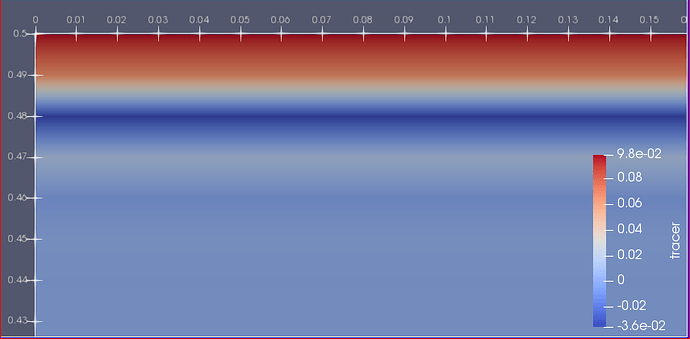Hey all,
I’m new to OGS and work with OGS 5 and coupled BRNS for my master thesis. For starters I try to implement a simple example of a tracer and simultaneous water pulse into an unsaturated 2D domain in OGS 5.
My Set-Up (in short):
The domain represents a 0.5m x 0.5m cross section through a soil column of a sandy soil, characterised by van Genuchten parameters.
IC is a PRESSURE1 GRADIENT (cross section is a XZ plane) with -31600 Pa at the bottom boundary and a gradient of 9810 Pa/m upwards (thus -36505 Pa at the upper boundary) and a conc. of 0 mmol C/g soil tracer in the entire domain.
BC for Richards flow PRESSURE1 are a constant bottom boundary of -31600 Pa and a time variable source term entering from the upper boundary. The source term represents a two hour long water pulse simulated by a Gauss curve in the .rfd file which adds a total of 10E-05 m3 of water into the domain. Additionally, a tracer is added throughout the first hour (also by a Gauss curve in .rfd) by a time dependant upper boundary condition for the tracer.
My Problem:
By running this set-up I get considerably large negative concentrations of tracer (in the order of E-02) one to two nodes from the concentration peak.
My question concerns the set-up of the numeric solver. Unfortunately, I couldn’t figure out which solver setting is appropriate for this problem. I tried to apply the numeric and time set-up of the HM benchmark in \DENSITY-DEPENDENT_FLOW\goswami-clement\wholeBC_PressAsHead_tri as it as well combines MASS_TRANSPORT with RICHARDS_FLOW. However, from the available documentation I couldn’t figure out how this set-up works and if it is applicable for my problem. Could anyone please help me in this regard - or might there be any other mistakes in my OGS set-up? I pasted the .num and .tim file below (not allowed to uplaod anything as a new user). Please let me know if you required any other files. I would highly appreciate any help and/or feedback!
Cheers,
Erik
NUM
$OVERALL_COUPLING
2 12
#NUMERICS
$PCS_TYPE
RICHARDS_FLOW
$LINEAR_SOLVER ; linear solver (2=BiCGSTab) , convergence crit.
2 6 1e-14 1000 1 100 4
$NON_LINEAR_ITERATION ; solver type , convergence crit. , iteration no. , preconditioner , error tollerance
PICARD ERNORM 25 0 1e-10
$COUPLING_CONTROL
ERNORM 0.001
#NUMERICS
$PCS_TYPE
MASS_TRANSPORT
$LINEAR_SOLVER
2 6 1e-14 5000 1 100 4
$COUPLING_CONTROL
ERNORM 0.001
#STOP
TIM
#TIME_STEPPING
$PCS_TYPE
RICHARDS_FLOW
$TIME_START
0.0
$TIME_END
200
$TIME_UNIT
DAYS
$TIME_CONTROL
SELF_ADAPTIVE
3 1.3
7 0.8
MIN_TIME_STEP
1e-05
MAX_TIME_STEP
10
INITIAL_STEP_SIZE ; set initial time step below Pulse temporal resolution
0.001
ITERATIVE_TYPE
COUPLED
STAY
3
#TIME_STEPPING
$PCS_TYPE
MASS_TRANSPORT
$TIME_START
0.0
$TIME_END
200
$TIME_UNIT
DAYS
$TIME_CONTROL
SELF_ADAPTIVE
3 1.3
7 0.8
MIN_TIME_STEP
1e-05
MAX_TIME_STEP
10
INITIAL_STEP_SIZE ; set initial time step below Pulse temporal resolution
0.001
ITERATIVE_TYPE
COUPLED
STAY
3
#STOP
